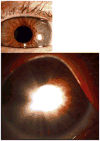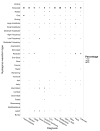The clinical evaluation of infantile nystagmus: What to do first and why
- PMID: 28177849
- PMCID: PMC5665016
- DOI: 10.1080/13816810.2016.1266667
The clinical evaluation of infantile nystagmus: What to do first and why
Abstract
Introduction: Infantile nystagmus has many causes, some life threatening. We determined the most common diagnoses in order to develop a testing algorithm.
Methods: Retrospective chart review. Exclusion criteria were no nystagmus, acquired after 6 months, or lack of examination.
Data collected: pediatric eye examination findings, ancillary testing, order of testing, referral, and final diagnoses. Final diagnosis was defined as meeting published clinical criteria and/or confirmed by diagnostic testing. Patients with a diagnosis not meeting the definition were "unknown." Patients with incomplete testing were "incomplete." Patients with multiple plausible etiologies were "multifactorial." Patients with negative complete workup were "motor."
Results: A total of 284 charts were identified; 202 met inclusion criteria. The three most common causes were Albinism (19%), Leber Congenital Amaurosis (LCA; 14%), and Non-LCA retinal dystrophy (13%). Anatomic retinal disorders comprised 10%, motor another 10%. The most common first test was MRI (74/202) with a diagnostic yield of 16%. For 28 MRI-first patients, nystagmus alone was the indication; for 46 MRI-first patients other neurologic signs were present. 0/28 nystagmus-only patients had a diagnostic MRI while 14/46 (30%) with neurologic signs did. The yield of ERG as first test was 56%, OCT 55%, and molecular genetic testing 47%. Overall, 90% of patients had an etiology identified.
Conclusion: The most common causes of infantile nystagmus were retinal disorders (56%), however the most common first test was brain MRI. For patients without other neurologic stigmata complete pediatric eye examination, ERG, OCT, and molecular genetic testing had a higher yield than MRI scan. If MRI is not diagnostic, a complete ophthalmologic workup should be pursued.
Keywords: Electroretinogram; magnetic resonance imaging; nystagmus.
Conflict of interest statement
The authors report no conflicts of interest. The authors alone are responsible for the content and writing of this article. Arlene V. Drack, MD, is a co-investigator in the Phase III RPE65 gene therapy trial which is funded by a grant from Spark Therapeutics.
Figures









References
-
- CEMAS Working Group. The National Eye Institute Publications. Bethesda, MD: The National Eye Institute, The National Institutes of Health; 2001. A National Eye Institute Sponsored Workshop and Publication on The Classification Of Eye Movement Abnormalities and Strabismus (CEMAS) ( www.nei.nih.gov). The National Institutes of Health.
-
- Brodsky MC, Keating GF. Chiasmal glioma in spasmus nutans: a cautionary note. J Neuroophthalmol. 2014 Sep;34(3):274–5. - PubMed
Publication types
MeSH terms
Grants and funding
LinkOut - more resources
Full Text Sources
Other Literature Sources
Medical
Research Materials
Miscellaneous
